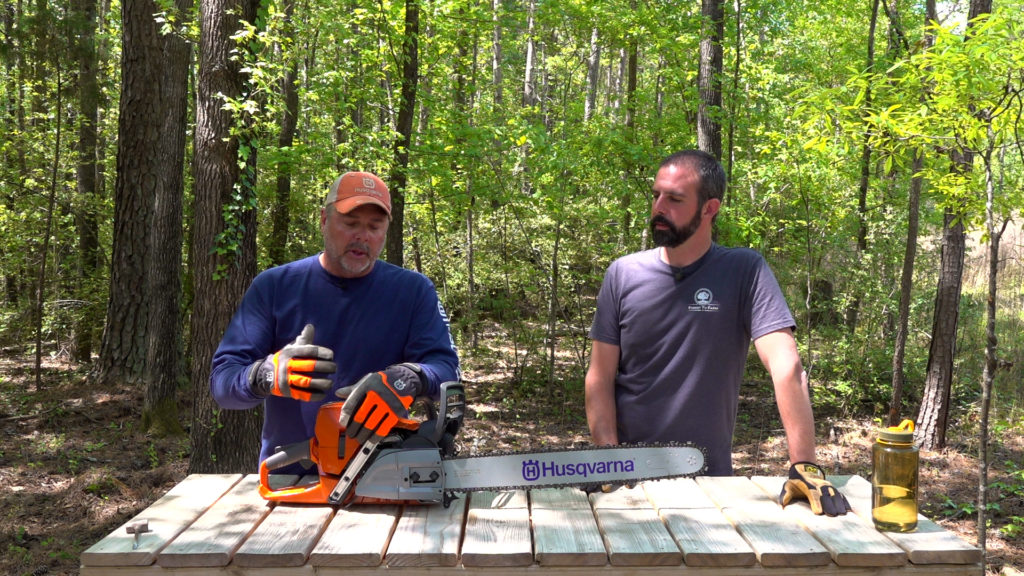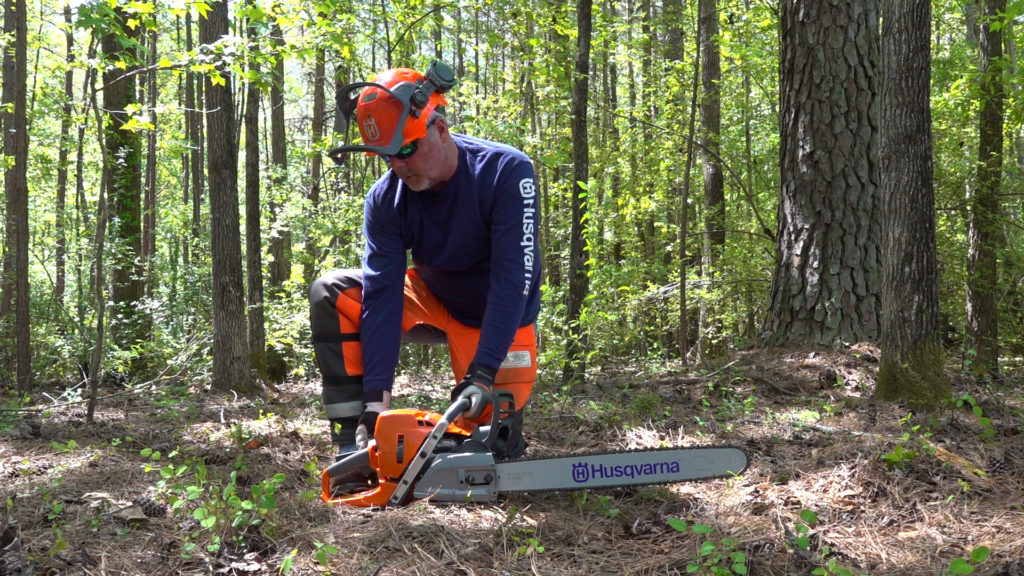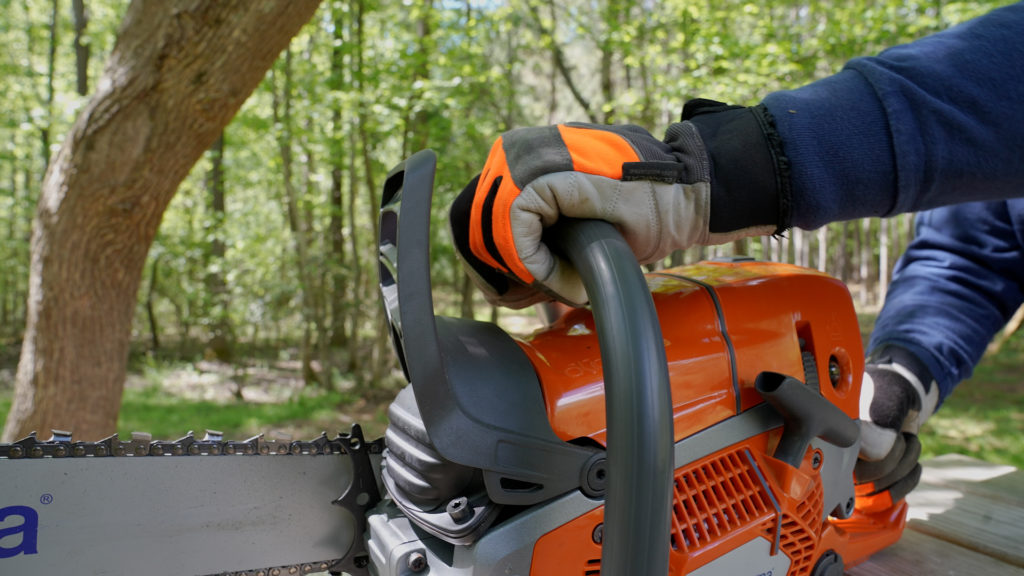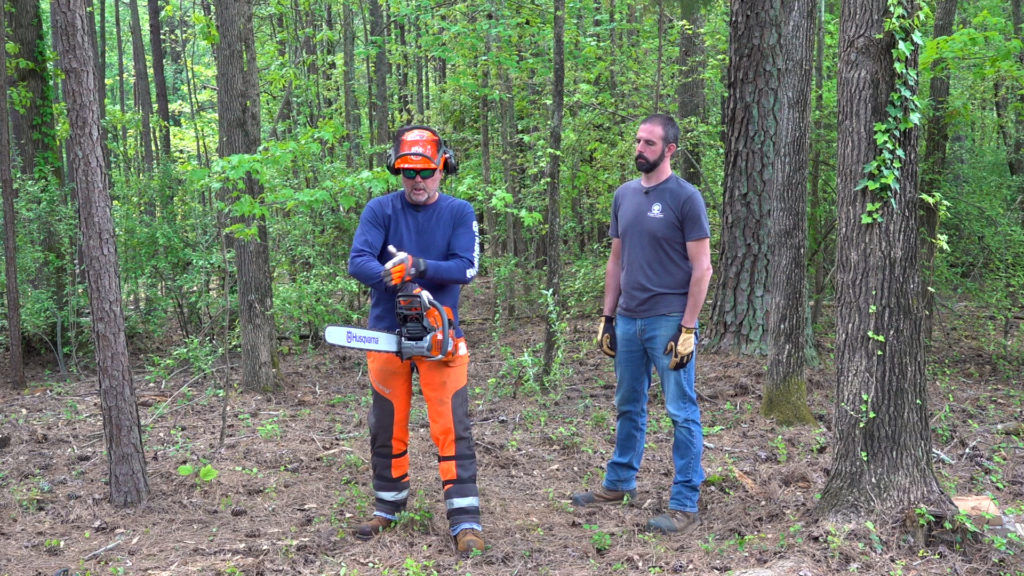
Welcome back guys! Brian & Terry here with The Forest to Farm Project. We are back with our sixth installment in the 7-part series on PPE with Scott from Husqvarna, and today we’ll be discussing the proper methods starting of a saw and saw operation.

The Expert:
- Name: Scott Martin
- Profession: Husqvarna Training & Sales Knowledge
- Time on The Job: 25 Years
Before you actually start the saw, you want to make sure you have your PPE (Personal Protective Equipment), chaps, helmet system, ear & eye protection, etc. that we’ve discussed in previous segments; and that you’re using it properly. Next, you want to inspect the saw and make sure it’s in good working order, with no broken or missing pieces. Make sure your chain catcher is in good shape and that your chain brake is operational.
Basically, make sure the saw is worthy of you getting behind it and doing the job at hand. Once you’ve verified all of that, there’s a proper procedure for starting the saw.
First, your chain brake needs to be engaged so that the chain won’t be moving in the event the saw starts on the first pull. If the chain brake is not engaged, the saw will usually run at a higher RPM when it first starts up and that could be a dangerous situation
Next, if you’re saw is equipped with it, you want to engage the decompression valve. By pushing the valve, you are allowing enough of the pressure inside the valve to escape that it makes starting the saw much easier. It generally allows about 40% of the pressure to be relieved. This makes it much easier to start; therefore, it’s easier on the starting mechanism and on your shoulder.

The next step, if your saw is equipped with one, would be to push the air purge to the point that the bulb fills up with fuel. This is not to be confused with a primer bulb because they really serve two different functions. Basically, what an air purge does is get fresh air from the tank into the carburetor and get the air out of the lines. Any excess fuel goes back into the tank, so there’s really no opportunity to flood a saw with this type of mechanism. On the other hand, a primer system basically floods the carburetor with fuel very easily.
In a cold start, when the saw hasn’t been run, you want to choke it. When I pull it, the saw will pop one time and cut off. At that point, you take it out of choke and put it into the “run” position. Then you will pull it again, making sure all the same steps are engaged as before (chain brake, decompression valve, air purge). It will run at a high RPM until you hit the throttle one time. This will release the “fast idle” and the saw is ready to go.
Now, there are two proper methods for starting a saw, the “Leg Lock” method and the “Ground Start” method. Let’s take a look at the Leg Lock method first.
Again, make sure the chain brake is engaged, decompression valve is engaged (if you have one), and the air purge has been pumped. Check your PPE, choke the saw, and you are ready to go. To start, put the corner of the forward grip in your left hand. Next take the saw and put it on the inside of your left knee and the place your right leg around the rear handle. Now the saw is pinned in this area and you have good control when you go to start the saw. This method is very easy, fast, and efficient.
Next, we have the Ground Start method. With this method, you place the saw on the ground and put your right foot through the stirrup of the grip. This gives you good control of the back of the saw. Your left hand goes on the top of the front handle and you get a standard full wrap on the handle. Again, make sure the chain brake is engaged, decompression valve is engaged (if you have one), and the air purge has been pumped. Check your PPE, choke the saw, and you are ready to go. In this method, the saw is pinned to the ground in a very controlled situation. It’s a very safe and effective way to start a saw.
Now, let’s look at some improper saw starting methods that are commonly used. First, we’ll look at the “Drop Start” method.
With this method, people will hold the saw in their left hand about waist high, turn it on by dropping the saw downward with their left hand while holding onto the pull with their right hand and this engages the starter mechanism. The problem with this is that the saw can turn on immediately. If it does start on the first pull, you’ve only got one hand on the saw and as you can see in the above photo, the saw is not in a stable or solid position. The bar can flop around and is in a very dangerous position because you don’t have full control of the saw.
Another improper method is where people will hold the saw facing downward in their right hand and pull the cord with their left hand. This is extremely dangerous because you risk ground contact with the bar and chain that could be running at a high RPM on the first pull, and again, you only have one hand controlling the saw.
Both of these air drop methods are very dangerous and not worth the risk. Both the Leg Lock and Ground Start methods are very easy, controlled, and efficient methods of starting the saw.
Now that we have a saw that’s running, let’s talk about using the saw in a work environment. One key thing you want to remember is, if you’re taking more than two steps in a workspace with the saw you want to make sure you’ve engaged the chain brake. Once you’re set and ready to make a cut, keep your thumb wrapped on the back side of the top handle, reach out with your fingers and grab the brake, pulling it toward you. Now you’ve disengaged the chain brake and you’re ready to make your next cut. To reengage the chain brake after your cut, it’s very easy to just roll your wrist forward and engage the brake again. It doesn’t really take any extra time and is a good habit to get into so that you stay in a relatively safe environment.
When moving about with the saw, you always want to carry it with the bar behind you.
You never want to travel with the bar facing forward because if you fall, you would be falling directly onto a sharp chain. Now, if anyone is following behind you, and you are carrying your saw properly, they need to make sure to leave you enough space that they are not at risk of falling on the sharp chain, should they lose their footing or trip over limbs or debris on the ground. Leave a safe distance between each other.
When it comes it comes to stance while running the saw, you should never have an open stance. In this stance, you don’t have a good way to deflect anything coming at you unexpectedly while cutting. You can very easily lose your balance and become injured.
Instead, you want to utilize a boxer-style stance. This gives you much more control and power when making your cuts. Saws are made to be run in a right-handed orientation, left hand forward, and right hand at the back. You never want to run a saw with your hands switched (pictured below).

Running a saw in this orientation is exceptionally dangerous because you have now crossed the plane of the bar with your body. Should you encounter a kickback, you have no defense against it and are in direct line for contact with a running saw.
If you are running a saw in the proper, right-handed orientation, you greatly reduce the risk of injury from a kickback scenario because the saw is no longer in a direct line of contact with your body.
Now, getting back to stance. If you’re in the boxer style stance, you are much more capable of deflecting or absorbing what comes at you unexpectedly when you are running the saw in its proper orientation.
Lastly, when you are making a cut, there is no need to look directly into the kerf of what you are cutting. The saw is going to do the work regardless. Watching the saw go into the kerf puts your face in direct line of contact if there is a kickback situation.
So, when it comes to operation of the saw, make sure you are using some common sense and be safe. Make sure your saw is in good running condition and that you have proper PPE for the situation at hand.
We hope you found this part of the PPE series informative and helpful when it comes to starting your saw and basic operation. Check back soon for the next installment in our chainsaw safety PPE series!
